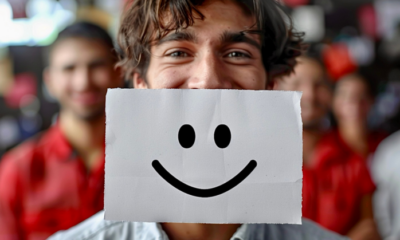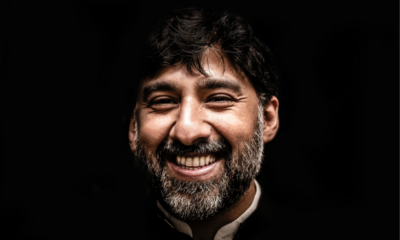Life
Identifying Your Emotions is the Key to Exponential Happiness

In the weeks and months following the heinous terror attacks of September 11, millions of Americans decreased their domestic air travel. As domestic flying decreased, car travel increased where a study found that people opted to drive longer distances rather than fly. Not taking into account 9/11, there were 331 airplane crash fatalities in the U.S from 1751 crash events. What’s interesting is there were 42,000 driving-related deaths in that same year. The number of deaths in air travel and road travel remained relatively consistent in subsequent years.
Statistics imply that post 9/11, Americans were more willing to risk mortality of long-distance car travel rather than adopt the minimal risk of air travel, presumably due to the perception of risk involved from terrorism threats. We can believe that the September 11 terrorist attacks may have resulted in a secondary toll of deaths as people made poor choices to avoid scenarios of risk. What has been made clear, is any large-scale threat to public safety affects our emotions and the decisions we make.
Our Emotional Responses
Our emotional responses are a reaction to the world around us. We’re supposed to smile at babies because it’s our evolutionary advantage to give infants positive emotions. We’re supposed to react with a fight or flight response under perceived danger because self-preservation is part of our DNA. What we don’t often think about is the thousands of micro reactions we face every day. The waiter at the restaurant is polite, so we respond with kindness.
The car next to us cuts us off in traffic, so we abuse them. While many emotional expressions are universal, sociocultural norms can dictate how we respond when coming across an intense emotion. For example, in Japan, people tend to hide their display of fear or disapproval when an authoritative figure is present. Conversely, in western culture like the United States, people are more likely to express their negative emotions in their presence and with others.
We can come across an intense emotion, not ignore it, control it, and use it to make the world a better place. Climate change, domestic abuse and human trafficking are all relevant examples in today’s world. Even protests of racial injustice become fueled by emotion. The adverse reaction we may feel about these issues can be used more positively by donating our time, helping others, or educating ourselves and those around us to become more aware.
Emotion is our human way of putting a meaningful stamp on our experiences. They are a key driver in our behaviour and shape our responses to what’s around us. Emotions enable us to make decisions, take action, connect and communicate with others, and build meaningful friendships and relationships. Our feelings are either short-lived or long-lasting. Understanding emotional behaviour in others informs us how to adapt our behaviour accordingly.
In our daily lives, we are often told not to ‘get too emotional’. When females show emotion, others see it as showing “too much”, or “overreacting”. Conversely, when men show too much emotion, or any form of emotion- Others may see it as being “weak”.
Emotions and Decision Making
Many of the decisions we make in our lives are almost instant and based on emotion. We’re not always in charge and can be too impulsive or deliberate for our own good. One moment we get a hot head and explode with the confidence of an idea; the next we’re paralysed by uncertainty. Antonio Damasio’s research has been instrumental in helping humans understand how emotions influence our behaviour- in particular, how we make decisions.
One of Damasio’s studies took a look into those who had damage to the brain’s emotional circuitry. In addition to finding that such people could not feel emotions, he also uncovered that they are unable to make decisions. The patients were able to describe the action they should be taking, but could not settle on a decision, even as simple as what to eat. Emotions enable us to weigh up options and come to what we believe to be the best outcome for ourselves. They are a vital component of our decision-making process.
When making a decision, we look for a way to satisfy a basic human need: happiness. It is why many of our choices are unconscious attempts to avoid guilt, fear and negative feelings, whilst trying to enhance our positive emotions simultaneously.
The strong influence our emotions have over our thought process means that our decisions are susceptible to error. And because we value our time, decisions are often fast and automatic, where we can feel a certain way for as long as possible. We then don’t often realise the full impact of the emotional interference in our decisions.
“Human behavior flows from three main sources: Desire, emotion and knowledge.” – Plato
3 Ways To Identify and Help Our Emotions
Our emotions are there for a reason. They act as the rudder of a ship that helps us navigate and steer through calm and rough seas. Taking time to understand our emotions and feelings not only spares us from unexpected breakdowns, but it’s also how we can create a happier self and live a happier life.
- Take time to engage with people. Read the emotions in their faces and show them you’re listening and paying attention. Visual feedback and facial cues often work well where your mirror neurons are activated and help you become more engaged.
- Communicate your emotions with others. Learn to articulate your thoughts and feelings and feel whether your automatic response is appropriate. Suppose you can identify the source of the emotional trigger. In that case, you will be able to assess the emotional temperature of a conversation better and defuse any tension through your actions.
- Slow Down. Think and assess what is happening around you. Our decision-making is capable of making errors in judgement and becomes easily influenced. By applying logical and rational thinking, you will be able to judge situations more effectively.
With exercising to help your emotions consistently, the growth that comes with it will set you up for success. Whether it’s personally or professionally, nurturing how you feel and becoming aware of strategies in dealing with emotions will create exponential happiness.
Did You Know
How Skilled Migrants Are Building Successful Careers After Moving Countries
Behind every successful skilled migrant career is a mix of resilience, strategy, and navigating systems built for locals.

Moving to a new country for work is exciting, but it can also be unnerving. Skilled migrants leave behind familiar systems, networks, and support to pursue better job opportunities and a better future for their families. (more…)
Life
10 Research-Backed Steps to Create Real Change This New Year
This New Year could finally be the one where you break old patterns and create real, lasting change.

Every New Year, we make plans and set goals, but often repeat old patterns. (more…)
Life
9 Harsh Truths Every Young Man Must Face to Succeed in the Modern World
Before chasing success, every young man needs to face these 9 brutal realities shaping masculinity in the modern world.

Many young men today quietly battle depression, loneliness, and a sense of confusion about who they’re meant to be.
Some blame the lack of deep friendships or romantic relationships. Others feel lost in a digital world that often labels traditional masculinity as “toxic.”
But the truth is this: becoming a man in the modern age takes more than just surviving. It takes resilience, direction, and a willingness to grow even when no one’s watching.
Success doesn’t arrive by accident or luck. It’s built on discipline, sacrifice, and consistency.
Here are 9 harsh truths every young man should know if he wants to thrive, not just survive, in the digital age.
1. Never Use Your Illness as an Excuse
As Dr. Jordan B. Peterson often says, successful people don’t complain; they act.
Your illness, hardship, or struggle shouldn’t define your limits; it should define your motivation. Rest when you must, but always get back up and keep building your dreams. Motivation doesn’t appear magically. It comes after you take action.
Here are five key lessons I’ve learned from Dr. Peterson:
-
Learn to write clearly; clarity of thought makes you dangerous.
-
Read quality literature in your free time.
-
Nurture a strong relationship with your family.
-
Share your ideas publicly; your voice matters.
-
Become a “monster”, powerful, but disciplined enough to control it.
The best leaders and thinkers are grounded. They welcome criticism, adapt quickly, and keep moving forward no matter what.
2. You Can’t Please Everyone And That’s Okay
You don’t need a crowd of people to feel fulfilled. You need a few friends who genuinely accept you for who you are.
If your circle doesn’t bring out your best, it’s okay to walk away. Solitude can be a powerful teacher. It gives you space to understand what you truly want from life. Remember, successful men aren’t people-pleasers; they’re purpose-driven.
3. You Can Control the Process, Not the Outcome
Especially in creative work, writing, business, or content creation, you control effort, not results.
You might publish two articles a day, but you can’t dictate which one will go viral. Focus on mastery, not metrics. Many great writers toiled for years in obscurity before anyone noticed them. Rejection, criticism, and indifference are all part of the path.
The best creators focus on storytelling, not applause.
4. Rejection Is Never Personal
Rejection doesn’t mean you’re unworthy. It simply means your offer, idea, or timing didn’t align.
Every successful person has faced rejection repeatedly. What separates them is persistence and perspective. They see rejection as feedback, not failure. The faster you learn that truth, the faster you’ll grow.
5. Women Value Comfort and Security
Understanding women requires maturity and empathy.
Through books, lectures, and personal growth, I’ve learned that most women desire a man who is grounded, intelligent, confident, emotionally stable, and consistent. Some want humor, others intellect, but nearly all want to feel safe and supported.
Instead of chasing attention, work on self-improvement. Build competence and confidence, and the rest will follow naturally.
6. There’s No Such Thing as Failure, Only Lessons
A powerful lesson from Neuro-Linguistic Programming: failure only exists when you stop trying.
Every mistake brings data. Every setback builds wisdom. The most successful men aren’t fearless. They’ve simply learned to act despite fear.
Be proud of your scars. They’re proof you were brave enough to try.
7. Public Speaking Is an Art Form
Public speaking is one of the most valuable and underrated skills a man can master.
It’s not about perfection; it’s about connection. The best speakers tell stories, inspire confidence, and make people feel seen. They research deeply, speak honestly, and practice relentlessly.
If you can speak well, you can lead, sell, teach, and inspire. Start small, practice at work, in class, or even in front of a mirror, and watch your confidence skyrocket.
8. Teaching Is Leadership in Disguise
Great teachers are not just knowledgeable. They’re brave, compassionate, and disciplined.
Teaching forces you to articulate what you know, and in doing so, you master it at a deeper level. Whether you’re mentoring a peer, leading a team, or sharing insights online, teaching refines your purpose.
Lifelong learners become lifelong leaders.
9. Study Human Nature to Achieve Your Dreams
One of the toughest lessons to accept: most people are self-interested.
That’s not cynicism, it’s human nature. Understanding this helps you navigate relationships, business, and communication more effectively.
Everyone has a darker side, but successful people learn to channel theirs productively into discipline, creativity, and drive.
Psychology isn’t just theory; it’s a toolkit. Learn how people think, act, and decide, and you’ll know how to lead them, influence them, and even understand yourself better.
Final Thoughts
The digital age offers endless opportunities, but only to those who are willing to take responsibility, confront discomfort, and keep improving.
Becoming a man today means embracing the hard truths most avoid.
Because at the end of the day, success isn’t about luck. It’s about who you become when life tests you the most.
Change Your Mindset
The Four Types of Happiness: Which One Are You Living In?
Most people chase success only to find emptiness, this model reveals why true happiness lies somewhere else.

In a world driven by rapid technological growth and constant competition, many people unknowingly trade joy for achievement. (more…)
-

 Business4 weeks ago
Business4 weeks agoWhy Your E-Commerce Fulfilment Is Probably Broken (And How to Fix It)
-

 Shift Your Mindset4 weeks ago
Shift Your Mindset4 weeks ago11 E’s That Define Every Great Leader And Why Most People Miss Them
-

 Did You Know3 weeks ago
Did You Know3 weeks agoThe Success Patterns You Inherited (And Didn’t Notice)
-

 Entrepreneurs3 weeks ago
Entrepreneurs3 weeks agoThe Essential Skills Every Entrepreneur Needs In 2026
-

 Business3 weeks ago
Business3 weeks agoThe Hidden Money Pit in Your Operations (and How to Use It)
-

 Change Your Mindset2 weeks ago
Change Your Mindset2 weeks agoHow to Turn Your Mind Into Your Greatest Asset (Instead of Your Enemy)
-

 Change Your Mindset2 weeks ago
Change Your Mindset2 weeks agoThe Silent Skill That Makes People Respect You Instantly
-

 Life1 week ago
Life1 week ago10 Research-Backed Steps to Create Real Change This New Year


























